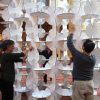Unlike every single other exercise this week, this one was a closed system- i.e. I had a really good idea in advance of how I wanted the final structure to look and feel. Size and scale represented the only opportunities for design input by participants. Much to surprise, this did not inhibit collaboration at all. Why? I chose to do a closed system because I wanted to get a baseline understanding of people’s pattern recognition skills with my disks. Pattern recognition is one determinant in how effectively people are able to participate in a design/learning process and how we design their engagement, and learning. In this case, despite having a relatively simple pattern, we ALL struggled mightily not to make mistakes. One theory is that because the disks are white, they tend to visually merge together making following even simple patterns a bit challenging. Another possibility is that the experience of assembly was still largely intellectual and not yet kinesthetic enough to make following the pattern an automatic action. Regardless, it was a blessing in disguise, forcing total strangers (age 4-72) to interact, negotiate and collaborate. (via Workshop #1: The Merits Of Absurdly Large, Impossible Challenges. | Public Workshop
)
